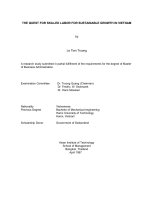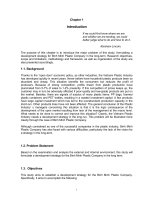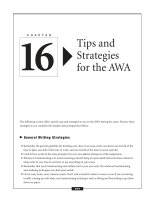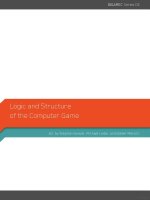Security information resources and strategies of the XXI century
Bạn đang xem bản rút gọn của tài liệu. Xem và tải ngay bản đầy đủ của tài liệu tại đây (1.86 MB, 7 trang )
Vol. 6, 2020
A new decade
for social changes
ISSN 2668-7798
www.techniumscience.com
9
772668
779000
Technium Social Sciences Journal
Vol. 6, 167-172, April 2020
ISSN: 2668-7798
www.techniumscience.com
Security information resources and strategies of the XXI
century
Violeta Ioana Nagat
PhD. Student - Academia de Informații "Mihai Viteazu", Bucharest, Romania
Abstract. National Intelligence is a priority of national security strategies and intelligence to
the US security and defence or in the UE States (Strategists/White Books), by which it is
proposed, for the first time, achieving an overall, systematic reforms and long term to this area
for important strands of which mention: coordination, structural transformations, the formation
of a new structureImprove the quality and activity of human resources reform in the
intelligence research, technical development capabilities for gathering information. The
dynamics of transformations is necessary to streamline the work of intelligence organizations.
In Romania there is an older Security Strategy (2006) and no Intelligence strategy, which
would need to be developed. Whatever the model and how to design, american or european, for
turning his Romanian intelligence is important for their effectiveness by the maximum of the
intelligence community and its components. All these directions and actions are required to be
prepared for the strategic change in the world and intelligenceul in order to meet the new
challenges of the 21st century.
Keywords. National Intelligence, UE States, Strategists/White Book, Security Strategy (2006,
Romanian intelligence
Enter resources and their management need
Any human activity is dependent on the resources, defined as stores or sources of
means likely to be sold in a given circumstance and how to use them in the production of
social values . Specialists claim that growth means the economy management resources based
on science + - charged primarily as raw materials and finished products handled within the
space and time the management procedures and the human capacity to maintain the ratio must
- availability in their recovery.
The problem is tackled multidimensional resources, in all social sciences, through an
interdisciplinary investigation, given the utmost importance, defining for all areas of social
life. Different theories and methods of investigation led to the identification, depending on the
interests and needs of two major categories of resources: human resources and material and
financial resources which, in the current era of information, plus information resources.
Human resources means all persons capable of producing social values by the
company at a time. Man has the ability to provide balanced relationship between resources
and needs between production and consumption for its own purposes, but also for society.
Man uses all other categories of resources, having the ability to forecast the evolution of
needs - resources report and to find ways to optimize resources through a continuous activity
167
Technium Social Sciences Journal
Vol. 6, 167-172, April 2020
ISSN: 2668-7798
www.techniumscience.com
identification, allocation and management of their. Therefore, the role of human resources that
are renewable, overwhelmingly identify and use all other categories of resources.
They are included in the category of economic resources specialists summarizing the
labor potential of a country, geographical areas etc. and can be considered, at generally
speaking, using indicators, such as age population available working population in the
working age population etc., level of education, health, share of different professional
categories of the population, etc.
The material resources include all "commodity" and finished products generating
materials needed company. These, together with soil and subsoil riches, techniques and
technologies form the capital, which is prerequisite to obtaining factor and economic goods.
They can be repeatable / reproducible, renewable / non renewable, abundant or scarce
recoverable / irrecoverable. Material resources are addressed in connection with the financial
resources that comprise all means, the funds held by the company at a time and can be used
for development and other specific needs. Today, the complexity of socio-economic processes
as a result of new information age technologies and specific needs regarding access to realtime material, led mutations in the thinking and action by reconsidering the role of
information in business organization and management processes of economic and social
development. So, the information of the content, organization and retrieval mode have utility
and availability for use by human factors knowledge in order, decision or action, are
information resources. This explains the concern at all levels of organizational structures for
obtaining timely, complete, accurate, appropriate, timely and accurate, by processing
analytical and synthetic skilled personnel and timely transmission of information products
obtained makers empowered order to capitalize quickly and efficiently.
To seize all resource categories, depending on interests and needs, they need to be
managed. In a general acceptation, management is regarded as management entity
independent production and active, mainly by sensing and correcting deviations found to a
number of conditions or benchmarks, controlled by a factor of authority and respect of legal
rules methodological and procedural. It is under the impact of the necessity to approach
prospective retrospective diminishing formal controls in favor of the concept, the transition
from analytical perspective to the interactive and inclusive, fostering continuity of
management time based smart change, information, skills, learning and organizational
knowledge, success and performance, as well as crisis situations.
In this regard, resource management can be defined as the action or set of operations
identifying, obtaining, processing and use of available depending on interests or needs. In the
current conditions it is also called management - with multiple meanings, such as handling,
steering, guidance, leadership, management, negotiation, transaction, two signifying, so "
basic driving skill " or directing efforts to use all resources in the most appropriate and most
efficient manner to achieve goals.
The management is a process of cognitive and action, whose basic elements are
people with responsibilities in human resources management, material and information (
called leaders or managers who design, administer and execute the work with management
functions ) ideas resulting strategies, objectives, policies and programs of action, and facts or
actions that produce social values. In this context, management (management) profession is
based and which reveals, ultimately, as "art human factor management, use of resources ".
This will strengthen the effectiveness of decisions taken (quality, speed,
communicability), understanding the behavior of personnel specialized in obtaining,
processing and use of resources and the possibility of objective assessment and monitoring
performance management activity.
168
Technium Social Sciences Journal
Vol. 6, 167-172, April 2020
ISSN: 2668-7798
www.techniumscience.com
Information resources
Informational resources is the defining element of management and organization of
any productive purpose activities used in the development and operation of all social systems
producing social values.
a) Definition of information resources
Concerns about the identification, definition and quantification of information
resources led to interpretations homogeneous background, but different shape. Most striking
are those given by economics, where information resources are defined as " information of the
content and manner of organization and retrieval have utility and availability for use by the
human factor, for the purposes of knowledge, decision or action ". Their importance in terms
of management and organization entity productive highlighted other defining elements
according to which information resources are perceived as "information, information,
information flow, models, methods, techniques and procedures, equipment, a carrier of
information, installations and objects inventory management and execution working staff. "
The combination of the two approaches lead to the conclusion that information
resources are the expression capacity of institutions ( organizations ) to create information
products through its own human and technical possibilities, as well as liaising with the
external environment, according to the interests and needs. This information acts as operator
of process knowledge base, decision and action and substance of interpersonal
communication.
Informational resources whose common element is the information there as support
files on classical electron magnetic or optical databases and databases managed by computer,
documentary collections ( including microfiche and microfilm ), computer information
records, funds patents, designs and patents, and information held by humans as objects of
managerial work.
So, information resources are essentially information obtained in the process of
information- management, methods, techniques and procedures which, in content, manner of
organization and relevance have utility and available for use in appropriate ways in order
knowledge, decision and action in relation to the interests and needs.
Informational resources is at the same time, information assets, which entail costs of
production, processing, transmission and reproduction, are perishable and subject to
obsolescence if not managed properly, but non-destructive nature, can be multiplied by
disseminating depending on interests and needs.
Century XXI century is marked by profound changes of the international security
environment. The world is becoming increasingly complex and interdependent, and
globalization as states increasingly irreversible. The emergence of a global economy, strongly
interconnected, reconfigures the system of international alliances, accelerate technology
adoption and deliver scale development of new economic centers. This interconnected world
offers new opportunities but growing number of companies and significant risk to
international security.
Regional instability, resulting from the spread of religious fundamentalism, massive
migrations of populations and competition for natural resources and other factors, constitutes
the coordinates that define new requirements for security and intelligence services.
Concerns states to organize effective national security services, a corresponding
vision of the US and the American system of security and intelligence and one of the two
representing the vision of EU Member States with significant concerns in developing and
implementing security strategies that include intelligence.
169
Technium Social Sciences Journal
Vol. 6, 167-172, April 2020
ISSN: 2668-7798
www.techniumscience.com
The system requires the establishment of US national security strategy, in which,
based on other strategies are developed security system and intelligence as we have discussed,
which are part of a hierarchical system of the US Intelligence Strategies.
In this system we find for each domain / subdomain of security (item) a specific
strategy.
Thus, the new security strategy reads:
This new National Security Strategy positions the United States to safeguard our
national interests through strong and sustainable leadership. It sets out the principles and
priorities to guide the use of American power and influence in the world.
First and foremost, we will lead with purpose. American leadership is a global force for
good, but it is grounded in our enduring national interests as outlined in the 2010 National
Security Strategy:
And
….These complex times have made clear the power and centrality of America’s indispensable
leadership in the world. We mobilized and are leading global efforts to impose costs to
counter Russian aggression, to degrade and ultimately defeat ISIL, to squelch the Ebola virus
at its source, to stop the spread of nuclear weapons materials, and to turn the corner on
global carbon emissions. A strong consensus endures across our political spectrum that the
question is not whether America will lead, but how we will lead into the future.
The president’s second National Security Strategy articulates a belief in a peaceful, rulesbased international order; it also reaffirms the fact that none of this can happen without the
leadership of the United States. For scholars seeking to trace broader themes in the
president’s foreign policy strategy, the document promises good historical value. But to
expect it to provide definitive answers to every crisis that now simmers across the globe —
that’s asking a bit much of any NSS1.( For national security intelligence as a sub domain of
the National Intelligence Strategy was developed (last in 2014), and sectored / sequential
Defense Intelligence Strategy ( Defense Intelligence Strategy, 2012-2017) and the National
Strategy on Intelligence (National Counter Intelligence Strategy, the last in 2009).
European states presented (UK, France, Spain) have developed a single document a single security strategy national, all integrating into a single document - the parties on
security and defense and intelligence site. Thus in France - this document is called White
Paper on national defense and security (Le Livre blanc sur la Defense et la National Security 2013 ) strategic doctrinal document security and defense, France, (see detail Importance and
role of intelligence in security strategies - case study: United Kingdom and France - Bulletin
National Defense University "Carol I " September 2014, pp 66).
In the UK there is a new National Security Strategy - National Security Strategy
NSS) - October 2010-2011.
New strategy of national security of Spain - 2011, whose necessity was obvious,
integrates values and interests on the basis of which it is based; to analyze the hazards, threats
and vulnerabilities as well as the causes that they generate, to establish the framework for
action and contain databases to provide a response in full, which will ensure protection of
national interests, while ensuring at the same time respect constitutional values and the
international treaties signed by Spain.
1
Obama's Last National Security Strategy | Foreign Affairs />
170
Technium Social Sciences Journal
Vol. 6, 167-172, April 2020
ISSN: 2668-7798
www.techniumscience.com
National Security Strategy -2011 is in harmony with the strategies adopted by the
international organizations to which Spain is a party to. Correct to suitability for strategic
developments in the situation must be ensured by periodic reforms.
In Romania there is an older Security Strategy (2006) and no Intelligence strategy,
which would need to be developed.
Whatever the model and how to design, american or european, for turning his
Romanian intelligence is important for their effectiveness by the maximum of the intelligence
community and its components. All these directions and actions are required to be prepared
for the strategic change in the world and intelligenceul in order to meet the new challenges of
the 21st century.
Conclusion
Intelligence activity is a national priority of the new strategy for security and
intelligence in the US or in the EU security and defense, which proposed the first time ever,
the overall achievement of a systematic and long term of this area regarding important strands
of which: Coordination, Structural transformations, the establishment of a new structure,
improving quality and human resources activity, reform intelligence related research,
developing technical intelligence capabilities. Dynamics change is necessary for efficient
business intelligence organizations.
References
[1] National Security Strategy of the United States of America 2015
[2] The National Intelligence Strategy of the United States of America (NIS) is a product
of the Office of the Director of National Intelligence (DNI).
[3] Le Livre blanc sur la defense et la securite nationale- French White Paper on defence
and national security – 2013 />[4] The National Security Strategy of the United Kingdom, Security in an interdependent
world, Cabinet Office, 2008;
[5] The National Security Strategy of the United Kingdom: update 2009, Security for the
Next Generation, Cabinet Office, 2009;
[6] The National Security Strategy of the United Kingdom, A Strong Britain in an Age of
Uncertainity, Cabinet Office, 2010;
[7] Dicţionar de economie, Editura “Economică”, 1999;
[8] Emil Mihuleac, Bazele managementului, Editura “Romfel” SRL, Bucreşti, 1993;
[9] W. David Rees, Arta managementului, Editura Tehnică, Bucureşti, 1996;
[10] Claude Silberzahn, Lean Guisnel, Au Coeur du secret, Paris, 1995.
[11] Cristian Troncotă, Horaţiu Blidaru, Careul de Aşi, Serviciile secrete ale Marii
Britanii, SUA, Rusiei şi Israelui, Editura Elion.
[12] Cristian Troncotă, Ioan Bidu, Horaţiu Blidaru, Serviciile secrete ale Franţei,
Germaniei, Italiei, Spaniei şi Portugaliei înainte şi după războiul rece, Editura,,Elion”,
Bucureşti, 2004
[13] Maior George Cristian, Incertitudine gândire strategică şi relaţii internaţionale în
secolul XXI, Editura RAO, Bucureşti 2009.
[14] Tiberiu Tănase, Puncte de vedere privind organizarea şi funcţionarea componentelor
sistemului de securitate al României, în volumul România şi consolidarea rolului
acesteia ca furnizor de securitate a XI-a Sesiunea de Comunicări 2005, Editura ANI,
vol. I.
171
Technium Social Sciences Journal
Vol. 6, 167-172, April 2020
ISSN: 2668-7798
www.techniumscience.com
[15] Tănase Tiberiu, Consideraţii privind organizarea şi funcţionarea unei Comunităţi
Naţio-nale de Informaţii performante, în Dinamica Inelligence-lui provocări,
oportunităţi şi priorităţi, a XIII-a Sesiune de comunicări ştiinţifice cu participare
internaţională, 15-16 martie 2007, Editura ANI, 2007, p. 203.
[16] Dr. Tiberiu Tănase and Anca Savu - The importance and the role of intelligence in
security strategies - case study: the uk and france importance and role of intelligence
in security strategies - case study: un- carol i “september, 2014, pp 66
[17] The National Security Strategy of the United Kingdom, Security in an interdependent
World,
Cabinet
Office,
March
2008,
/>df, p. 40 (4.51).
[18] The National Security Strategy of the United Kingdom-2008 (5.6).
[19] Carta Albă/Strategia franceză de securitate şi apărare,
Strategia de intervenţie a Franţei.
[20] Cyber
Security
Strategy
/>[21] Livre blanc sur la défense et la sécurité nationale, www.defense.gov.fr/livre_blanc
[22] Denécé Eric, Le renseignement françaises en chantier- www.cf2r.org.
[23] Omand David, The National Security Strategy: Implications for the UK intelligence
community. A discussion paper for the IPPR Commission on National Security for the
21st Century, February 2009.
[24] Petit Jacques, Livre blanc et drones, în Defense nationale et sécurité collective, iunie
2009.
[25] />[26]
[27]
[28] http: / / www. interi cur. gouv. Fr
[29] />[30] htp://www.premier-ministre.gouv.fr/IMG/pdf/livre_ blanc_tome1_partie2.pdf.
[31] />[32]
172









